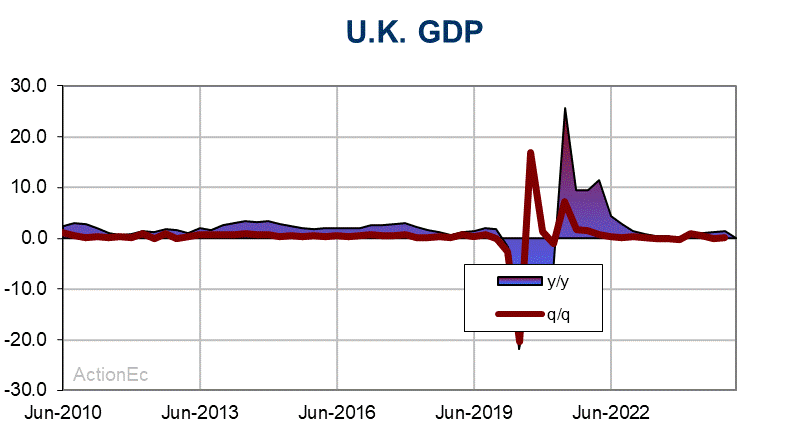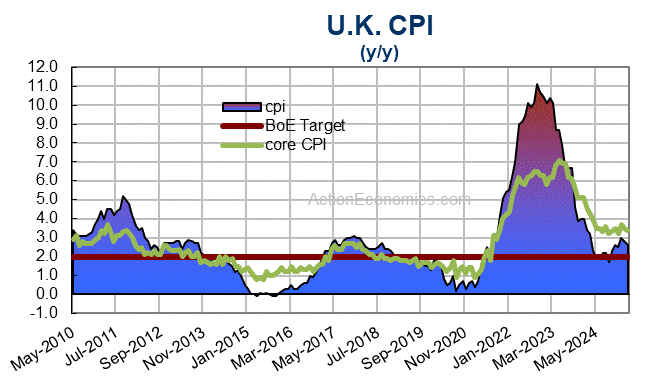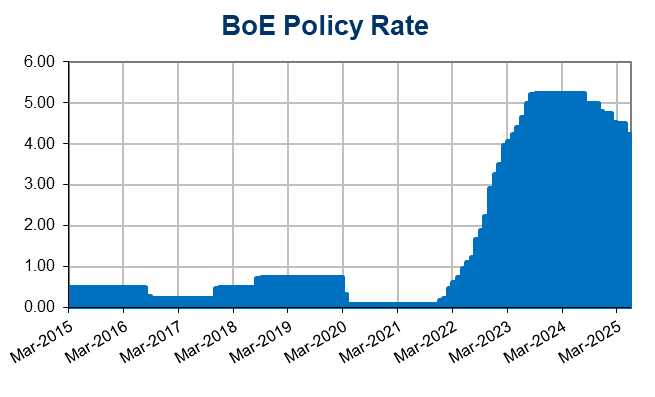The BoE sounded decidedly dovish last week, but subsequent data releases suggest that this was partly an attempt to prevent markets from pricing out rate cuts. And while GDP numbers looked better than anticipated, BoE surveys flag weaker than expected consumer demand. This should help to keep a lid on inflation, and it should keep the BoE on course to cut rates over the summer.

The UK economy bounced back in the first quarter of the year from a mild technical recession through the second half of 2023. Data released last week showed that GDP expanded 0.6% q/q though, following declines of -0.3% in Q4 and -0.1% in Q3 of last year. Activity was higher than in the first quarter of 2023, suggesting that activity is strengthening, despite restrictive monetary conditions.
However, despite this, the BoE’s latest monetary policy report flagged that contacts of BoE agents were still disappointed with consumer spending on goods and services through the Q1. As a result, they have downgraded their expectations for growth this year. Contacts remain cautiously optimistic that quarterly sales volumes will pick up in line with an expected rise in real incomes. Lower energy prices and a potential reduction in Bank Rate are expected to contribute to that.
Indeed, wage growth has remained strong, and data this week showed that regular pay growth (excluding bonuses) was 6.0% — driven by a 6.3% rise in earnings growth for the public sector. For the private sector, earnings growth came in at 5.9%. This is still a high number, especially considering weak productivity growth, though the ONS flagged that private sector wage growth was last lower in June of 2022 when it came in at 5.4%. However, in real terms, and adjusted for CPIH inflation, regular wages were up 2.0% y/y through the first quarter — leaving the highest rise in real wages since the third quarter of 2011.
While this is good for consumers as real disposable income is finally picking up, for the BoE, sticky wage growth remains a problem. The Monetary Policy Report last week noted that “second-round effects from past inflation are expected to take longer to unwind than they did to emerge, contributing to more persistently high wage growth”. The central bank’s chief economist also noted this week that given developments in productivity, wage growth is still “quite well above” “what would be consistent with the 2% inflation target being met on a lasting and sustainable basis”. However, Pill also noted that services price inflation “does seem to have peaked” and given the less optimistic growth outlook for consumption trends going forward, the services sector may indeed struggle to pass on higher wage costs.
Looking ahead, the latest KPMG and REC report on jobs noted that pay growth continued to strengthen in April and that permanent “salaries rose to the fastest degree in 2024 so far, whilst temporary wage inflation was the strongest for nearly a year”. Also it show unemployment rising gradually over the next year, and “signaled a further decline in permanent placement made by U.K. recruitment consultants”, with reports of “heightened caution among clients.

However, with inflation coming down, real wage growth remains sticky. This also reflects a labor market that remains relatively tight, partly due to a drop in labor supply since the pandemic. Looking ahead, though, surveys suggest that more candidates are available now, while the number of redundancies is rising. With inflation falling, this should prompt pay growth to continue to level off.
Indeed, the labor market in the UK is much more flexible than the Eurozone’s job market. This should ensure a relatively fast adjustment of wages to a pick-up in unemployment and an improvement in labor supply.
Meanwhile, information on April pay settlements would soon become available, including from the Bank’s Agents’ intelligence, which will be a key part of the puzzle, as these settlements should be the last that still play catch up with the sharp rise in inflation through recent years and the resulting erosion of real disposable income. The BoE will also have more information on the extent to which companies are forced to absorb higher wage costs via profit margins.

If there are no negative surprises, it should help to pave the way for a rate cut as early as June, even if the Fed delays the start of the easing cycle. Indeed, the BoE’s main message at last week’s statement and indeed BoE comments in the weeks before the meeting, was that the UK is more aligned with the policy cycle in the Eurozone than the US. This means markets risk being too pessimistic on the rate outlook for the UK, not just regarding the timing of the first move but also the magnitude of rate cuts this year.
However, while the UK and Eurozone economies are facing similar challenges at the moment, and cycles are pretty much aligned, the UK is a much smaller economy. This means exchange rate developments matter more, and if the UK moves much earlier than the Fed, the impact on Sterling would be felt via imported inflation. The BoE faces a difficult balancing act, especially as public pressure on the BoE to cut is rising. The government is facing elections and has to deliver an upbeat message on inflation and the general population is struggling with high financing costs, which is also impacting the housing market. If inflation falls toward target, the BoE will be pushed to deliver, even if its own forecasts suggest another uptick in the headline rate later in the year.
Click here to access our Economic Calendar
Andria Pichidi
Market Analyst
Disclaimer: This material is provided as a general marketing communication for information purposes only and does not constitute an independent investment research. Nothing in this communication contains, or should be considered as containing, an investment advice or an investment recommendation or a solicitation for the purpose of buying or selling of any financial instrument. All information provided is gathered from reputable sources and any information containing an indication of past performance is not a guarantee or reliable indicator of future performance. Users acknowledge that any investment in Leveraged Products is characterized by a certain degree of uncertainty and that any investment of this nature involves a high level of risk for which the users are solely responsible and liable. We assume no liability for any loss arising from any investment made based on the information provided in this communication. This communication must not be reproduced or further distributed without our prior written permission.



















